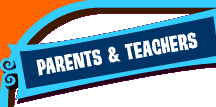| Lesson
Plans
LESSON:
EXPERIENCING LANGUAGE WITH FRIENDS
Grades: 1-4
Subject Areas: Language Arts, Life Skills,
Physical Education
Estimated Time: Two 40-minute sessions
I. Summary: Maya
and Miguel’s friends and neighbors come from many
different places, and this diversity is what makes these
characters and their friends so special to know! This lesson
focuses on the concept of friendship through vocabulary,
conversational language and role play. Students will be
introduced to bilingual age-appropriate greetings and participate
in activities that will support cultural, social and academic
growth.
II. Objectives:
- Students will be given opportunities to express their
feelings about their own experiences in developing new
relationships
- Students will experience language through reading and
visual media
- Students will role play how to greet a new friend in
English and Spanish
III. Materials:
- Maya & Miguel episode "When Maya Met
Andy" (first 30-minute session)
- Individual sets of English/Spanish greetings on index
cards, created by participation in printout activity
- Lesson printout: Greetings in
English and Spanish: A Bilingual Flip Chart
IV. Procedure:
(Session One)
1. Invite children to share personal experiences and feelings
about missing old friends and making new friends. Allow
everyone to connect with this concept by asking if anyone
has ever moved to a new place or if anyone has ever experienced
someone new moving into their neighborhood or school, especially
someone that looked “different” or spoke in
an unfamiliar language.
2. Video presentation of Maya
& Miguel episode "When Maya Met Andy." Encourage
students to describe each character’s experience in
meeting a new friend. Ask students to share similar experiences
and elaborate on thoughts and feelings about meeting new
friends.
(Session Two)
3. Introduce activity by sharing with students that learning
a second language can be very exciting and a great way to
make new friends and to have a better understanding of other
cultures. Ask students if they have ever heard someone speak
a language that they did not understand. Prompt discussion
by asking: How do people learn language? Who personally
taught them how to speak and understand language? How do
babies know what language to use when they begin speaking?
Inform students that we learn language best by experiencing
language, and that’s just what this lesson is all
about…experiencing language with friends!
4. Using printout Greetings
in English and Spanish: A Bilingual Flip Chart, model
correct pronunciation and rhythm. Invite students to model
language. Reinforce/repeat correct pronunciation. Practice
for rhythm and fluency.
5. Discuss how these greetings might
help new friends feel more comfortable when meeting for
the first time. Invite volunteers to demonstrate reading
and speaking each greeting.
6. Before role playing, demonstrate
age-appropriate body language to use while greeting someone
new, like sharing a big smile, extending a hand or waving.
Allow students to move about and practice their conversational
greeting skills.
| Greetings |
|
| English |
Español
|
| Hello!
My name is …. |
¡Hola!
Me llamo… |
| What
is your name? |
¿Cómo
te llamas? |
| What
language do you speak? |
¿Qué
idioma hablas? |
| Welcome
to the neighborhood. |
Bienvenido
a nuestro vecindario. |
| I am
glad you moved here. |
Me
alegro que te hayas mudado aquí. |
| I have
a pet. Do you have a pet? |
Yo
tengo una mascota. ¿Tú también
tienes una? |
| Let’s
be friends and play together! |
Vamos
a ser amigos, vamos a jugar. |
V. Assessment: Student
should actively participate in greeting exercises and successfully
demonstrate conversational language skills during role play.
Orally demonstrate vocabulary comprehension and exhibit
age-appropriate body language.
VI. Extensions in Learning:
- Continue practicing conversational language by reading
these bilingual books: Say Hola to Spanish Otra Vez
by Susan Middleton Elya (Ages 5-10) and Best Best
Colors by Eric Hoffman (Ages 5-8). Encourage students
to respond as they recognize familiar vocabulary and graphics.
- Create a treasure chest of words by having each student
write newly discovered bilingual words and phrases on
index cards. Decorate a card box with glued shells, net
and sand. Use new words/phrases throughout lessons to
reinforce conversational vocabulary and language skills.
- Invite a diverse group of community friends to come
and share various native language translations of basic
greetings and words.
Related National Standards
(These are established by McREL at URL: http://www.mcrel.org/standards-benchmarks/.)
Language Arts
- Makes contributions in class and group discussions
(e.g., reports on ideas and personal knowledge about a
topic, initiates conversations, connects ideas and experiences
with those of others)
- Listens to classmates and adults (e.g., does not interrupt,
faces the speaker, asks questions, summarizes or paraphrases
to confirm understanding, gives feedback, eliminates barriers
to effective listening)
- Uses writing and other methods (e.g., drawing pictures,
using letters or phonetically spelled words, telling,
dictating, making lists) to describe familiar persons,
places, objects or experiences
- Uses reading skills and strategies to understand and
interpret a variety of informational texts
- Understands the main idea or message in visual media
(e.g., pictures, cartoons, weather reports on television,
newspaper photographs, visual narratives)
Life Skills
- Students will express themselves in a positive and
appropriate manner
- Students will make friends
- Students can analyze effective communication skills
and express why they are successful
Physical Education
- Uses concepts of space awareness and movement control
with a variety of basic skills (e.g., running, hopping,
skipping) while interacting with others
Related National Standards
for ESL- Grades Pre-K-3 (These are established
by TESOL at URL: http://www.tesol.org/assoc/k12standards/it/07.html.)
- Goal 1, Standard 1 - To use English to communicate
in social settings: Students will use English to participate
in social interactions
- Goal 3, Standard 3 - To use English in socially and
culturally appropriate ways: Students will use appropriate
learning strategies to extend their sociolinguistic and
sociocultural competence
|
|








